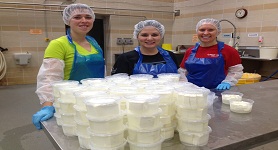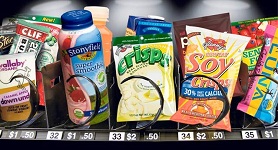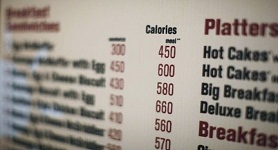By: Melissa Sales
One of the goals of the Food and Fermentation Science Club at Oregon State University is to process foods for the OSU Emergency Food Pantry. The pantry serves not only students in need, but also the Corvallis community, and is open twice a month. This is a great way for us to use the skills we have learned during our education to benefit our local community.
This past weekend, students from our club gathered to make feta cheese for the pantry, an event that was made possible by a donation of milk from the Paul and Sandy Arbuthnot Fund. This was a great opportunity to make a high quality, protein rich product that is always in high demand at food pantries. On Saturday, we pasteurized the milk, added cultures and rennet, separated curds and whey, then packed the curds into molds. The fermentation was allowed to continue overnight and on Sunday, the cheese was cut and packaged. We made a total of 75 6.5oz packages of feta!
In the past, we have made jelly with donations from Kerr Concentrates and plan on making blackberry jam with a donation from the Department of Horticulture in the spring. This was our first venture into dairy products and definitely plan on doing this again in the future!
Photo information (all students are Food Science and Technology)
Claire Oslund, Junior; Melissa Sales, Master's Student; Virginia Usher, Senior






That is awesome! We used to make cheese at Texas Tech for one of our fundraisers and it was always a fun time. I love the idea of getting donations and then donating the product to those in need. Can you share with us how you go about getting the donations (Do you contact the companies? Do you tell them they will get a certain amount of advertisement?)? We’d love to hear your tips for doing something like this, so other clubs can venture into this type of community service.
Hi, Emily! I’d love to share! The first time we made a product for the pantry, it was jelly made with concentrates. We knew we wanted to make jelly because the pantry often needs it, but didn’t really know where to start. We asked our pilot plant manager, Jeff Clawson, and he pointed us in the right direction about who to contact for donations. Companies get really excited about being able to contribute to projects like these, so I would just start asking. The worst that can happen is they say no.
The cheese idea actually came from Paul Arbuthnot. He had heard a story about an elementary school teacher that was buying cheese snacks for students to help them concentrate. The idea for using the creamery to make a cheese product for the pantry blossomed from there.
OSU is in the middle of an agricultural haven, so we have some gleaning opportunities here. The blackberries that we will make jam with were grown at one of our research extension centers and the Department of Horticulture didn’t have a use for them after they collected their data. They were kind enough to donate berries and we have them frozen until we can process them.
If a chapter wanted to get started with a project like this, I would contact a pantry and find out what their needs are and then think about what their processing capabilities are. From there, it’s just a matter of coordinating! There is so much that food science can contribute to food insecurity solutions and I really encourage all clubs to use what makes them unique to try a project sometime!
Great work .. every one ..